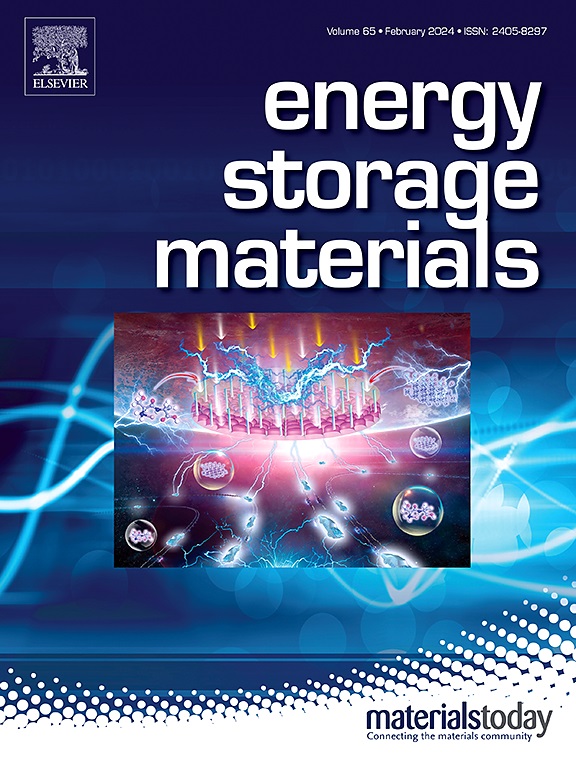Optimization strategies for high performance zinc-ion hybrid supercapacitors: Advances in materials, interfaces and devices
IF 20.2
1区 材料科学
Q1 CHEMISTRY, PHYSICAL
引用次数: 0
Abstract
Zinc-ion hybrid supercapacitors (ZIHSs) have become a popular candidate for the next generation of energy storage systems due to their high safety, low cost, environmental friendliness, and high power density-high energy density balance. However, at present, ZIHSs still face low energy density, insufficient understanding of the electrochemical energy storage mechanism, and side reactions and stability issues of zinc anodes. Considerable efforts have been invested and many key advances have been made to address these practical application challenges in the recent years. This work analyzes the research advancements in zinc-ion supercapacitors, emphasizing their energy storage mechanisms, key material designs, and performance optimization strategies. First, the device composition and energy storage mechanisms of ZIHSs are introduced. Subsequently, methods to enhance the capacity and cycling stability, as well as improve the rate performance, are evaluated in terms of anode materials design, zinc anode modification strategies (involving interfacial engineering and structural design), and electrolyte optimization approaches (covering aqueous, quasi-solid-state, and multifunctional additives). Furthermore, the generation mechanisms of zinc dendrites and HER, along with corresponding interface modification strategies, are systematized. Novel optimization frameworks involving electrode materials are also presented. Finally, the opportunities and challenges confronting this field are discussed, and potential future research directions are outlined. Overall, this review provides novel perspectives and actionable recommendations for the advancement of ZIHSs.


高性能锌离子混合超级电容器的优化策略:材料、界面和器件的进展
锌离子混合超级电容器(zhss)由于其高安全性、低成本、环保、高功率密度-高能量密度平衡等优点,已成为下一代储能系统的热门候选材料。然而,目前zihs仍面临能量密度低、电化学储能机理认识不足、锌阳极副反应和稳定性等问题,在解决这些实际应用挑战方面已经投入了大量的努力并取得了许多关键进展。本文分析了锌离子超级电容器的研究进展,重点介绍了锌离子超级电容器的储能机理、关键材料设计和性能优化策略。首先,介绍了zihs的器件组成和储能机理。随后,从阳极材料设计、锌阳极改性策略(包括界面工程和结构设计)和电解质优化方法(包括水性、准固态和多功能添加剂)等方面对提高容量和循环稳定性以及提高倍率性能的方法进行了评估。此外,还系统阐述了锌枝晶和HER的生成机理以及相应的界面修饰策略。还提出了涉及电极材料的新型优化框架。最后,讨论了该领域面临的机遇和挑战,并对未来可能的研究方向进行了概述。总之,这篇综述为zihs的发展提供了新的视角和可行的建议。
本文章由计算机程序翻译,如有差异,请以英文原文为准。
求助全文
约1分钟内获得全文
求助全文
来源期刊

Energy Storage Materials
Materials Science-General Materials Science
CiteScore
33.00
自引率
5.90%
发文量
652
审稿时长
27 days
期刊介绍:
Energy Storage Materials is a global interdisciplinary journal dedicated to sharing scientific and technological advancements in materials and devices for advanced energy storage and related energy conversion, such as in metal-O2 batteries. The journal features comprehensive research articles, including full papers and short communications, as well as authoritative feature articles and reviews by leading experts in the field.
Energy Storage Materials covers a wide range of topics, including the synthesis, fabrication, structure, properties, performance, and technological applications of energy storage materials. Additionally, the journal explores strategies, policies, and developments in the field of energy storage materials and devices for sustainable energy.
Published papers are selected based on their scientific and technological significance, their ability to provide valuable new knowledge, and their relevance to the international research community.
 求助内容:
求助内容: 应助结果提醒方式:
应助结果提醒方式:


